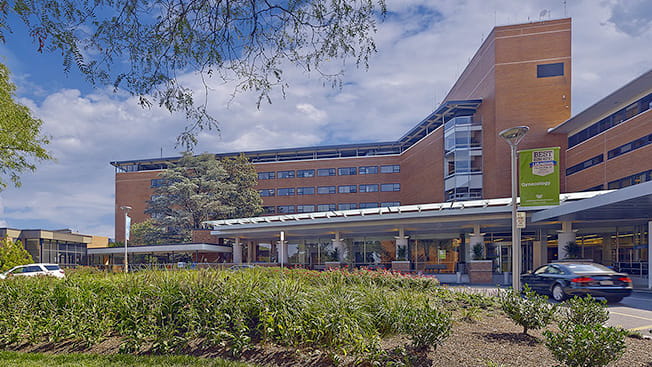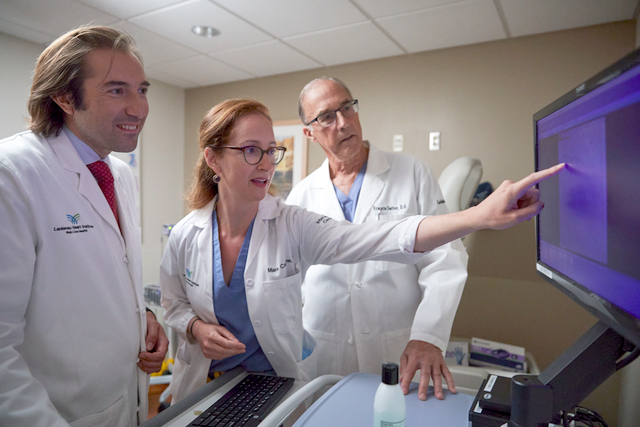Percent of patients at Lankenau Medical Center having minimally invasive surgery for coronary bypass far exceeds other U.S. hospitals

Despite older population, long-term clinical outcomes for Lankenau Medical Center-pioneered procedure are as consistently strong as the nation’s top clinical trials. It shortens recovery.
Wynnewood, PA — In 2005, Francis Sutter, DO, Chief of Cardiac Surgery at Lankenau Medical Center, part of Main Line Health, pioneered an advancement in the field of coronary artery bypass surgery—offering an alternative approach to traditional open-heart surgery. Lankenau launched one of the nation’s first programs for minimally invasive, robotic-assisted cardiac bypass surgery, seeking to reduce risks and decrease long-term complications as well as dramatically cut recovery time.

Results presented last week by Main Line Health physician researchers at one of the world’s leading organizations for cardiothoracic surgeons showed the percentage of patients at Lankenau having bypass surgery performed robotically is nearly 50 times higher compared to the rest of the nation’s medical centers. The research also demonstrated that, despite an older patient population, Lankenau’s long-term outcomes over 16 years were consistent or better than those in groundbreaking international clinical trials.
Results were presented Saturday at the Society of Thoracic Surgeons (STS) annual meeting in San Diego by the Lankenau Institute for Medical Research (LIMR) study’s lead investigator. LIMR is Main Line Health’s research division.
“It’s gratifying to see these results place Lankenau at the leading edge,” said Sutter, who accompanied professor Aleksander Dokollari, MD, PhD, Lankenau cardiac surgery researcher and presenter at the event. “I began performing the robotic procedure in 2005 because the traditional open-heart method was often too traumatic for older patients. Even if you conducted the procedure flawlessly, they tended not to fare as well. We now know for certain that robotic bypass surgery not only gives them a better chance but allows patients to recover more quickly.”
In 2021, 54.9% of all coronary artery bypass procedures performed at Lankenau were done robotically, according to the most recent annual STS reporting data, compared to 1.2% performed nationally.
“These kinds of results are why cardiac specialists throughout the region refer coronary bypass patients to us,” said Katie Galbraith, MBA, FACHE, President, Lankenau Medical Center. “High volumes lead to better outcomes. Most importantly, we’re getting patients back to their daily activities, home to their families and back to work faster. I’m grateful to LIMR’s researchers for compiling and analyzing the data that illustrates we are national leaders in robotic coronary bypass surgery. I know our team is dedicated to only getting better.”
The team at Lankenau has performed more than 2,500 robotic bypass surgeries to date. Sutter has personally performed over 2,300 of them, more than any surgeon in the United States. Gianluca Torregrossa, MD, joined as the director of the Robotic Coronary Revascularization Program at Lankenau Heart Institute in 2021, with the goal to drive further innovation.
With minimally invasive coronary bypass surgery, patients get back to their daily lives in half the time compared to recovery from an open-heart procedure. The surgeon needs only three to four very small keyhole incisions for inserting the robotic arms and camera in between the ribs, and the heart is kept beating during the procedure. With the traditional bypass procedure, the surgeon makes a 10-inch chest incision and cuts through the breastbone. The patient is placed on a heart-lung machine and the patient’s heart is stopped. The vast majority of robotic and traditional bypass patients at Lankenau are taken off the ventilator before leaving the operating room. Most traditional bypass patients at other institutions are not.
Detailed results of the LIMR research are as follows:
- The fifteen-year survival rate for Lankenau bypass patients was comparable to that found in the trial to which it was compared. Notably, the Lankenau patients on average were significantly older (71 years old) than those in the comparison trial (65).
- The low percentage of surgeries free of major adverse events (death, myocardial infarction, need for repeated procedure) was comparable to trial results published in the New England Journal of Medicine despite the same average age difference.
- Hospital complications such as postoperative atrial fibrillation and the need for transfusion due to bleeding were lower when compared to results of two trials.
As with traditional coronary artery bypass surgery, females in the general population undergoing robotic coronary bypass surgery had higher rates of blood transfusion, postoperative atrial fibrillation (irregular heart rhythm) and a higher risk of requiring repeat coronary intervention in the cardiac catheterization lab, the authors found. Women generally have a lower body mass index, which correlates with smaller coronary vessel size and, thus, potentially greater vulnerability to certain complications. The findings are in line with other clinical studies.
The other coauthors were Michel Pompeu Sá, MD, MSc, PhD; John Malin, DO; Serge Sicouri, MD; MaryAnn C. Wertan, RN; Basel Ramlawi, MD, chief of cardiothoracic surgery, Main Line Health; and Gianluca Torregrossa. The study reviewed data for all patients undergoing robotic bypass from 2005 to 2021.
Overall, long-term outcomes were comparable between robotic-assisted and traditional bypass surgery.
About Lankenau Medical Center
Lankenau Medical Center, part of Main Line Health, has been devoted to the health and well-being of the community since 1860, with a founding mission to serve all those in need. Our continued dedication to service, compassionate patient care and superior clinical programs makes Lankenau a preferred destination for care by people throughout the Philadelphia region and beyond. Lankenau offers primary care, disease prevention and specialized medical and surgical management of all diseases and disorders, as well as access to clinical trials. As a 371-bed teaching and research institution, Lankenau is committed to maintaining high-level expertise across all clinical areas and is consistently recognized for providing outstanding care across major specialties including heart and vascular care, cancer care, obstetrics and gynecology, orthopaedics, gastroenterology, pulmonology, neurosurgery, nephrology and urology. Lankenau is ranked as one of the top three hospitals in the region and top seven in the state by U.S. News & World Report 2023-24. It is rated a high performer in the Centers for Medicare and Medicaid Services' Overall Hospital Quality Star Rating.
About Lankenau Institute for Medical Research
Lankenau Institute for Medical Research (LIMR) is a nonprofit biomedical research institute located on the campus of Lankenau Medical Center and is part of Main Line Health. Founded in 1927, LIMR's mission is to improve human health and well-being. Using its ACAPRENEURIALTM model that integrates academic and entrepreneurial approaches, faculty and staff are devoted to advancing innovative new strategies to address formidable medical challenges including cancer, cardiovascular disease, tissue regeneration, gastrointestinal disorders and autoimmune diseases such as diabetes and arthritis. LIMR's principal investigators conduct basic, preclinical and clinical research, using their findings to explore ways to improve disease detection, diagnosis, treatment and prevention. They are committed to extending the boundaries of human health through technology transfer and training of the next generation of scientists and physicians.
About Main Line Health
Founded in 1985, Main Line Health is a not-for-profit health system serving Philadelphia and its suburbs. Main Line Health's commitment — to deliver safe, high-quality, equitable and affordable care for treating and curing disease, playing an important role in prevention and disease management, as well as training physicians and other health care providers — reflects our intent to be the region's premier choice for clinical care, research, and education. A team of more than 13,000 employees and over 3,500 employed and independent physicians and advanced practice providers care for patients throughout Main Line Health.
At Main Line Health's core are four of the region's most respected acute care hospitals — Lankenau Medical Center, Bryn Mawr Hospital, Paoli Hospital and Riddle Hospital — as well as one of the nation's premier facilities for rehabilitative medicine, Bryn Mawr Rehab Hospital.
Main Line Health also includes Mirmont Treatment Center for drug and alcohol recovery; Main Line Health HomeCare & Hospice, which includes skilled home health care, hospice and home infusion services; Main Line Health Centers, primary and specialty care, lab and radiology, and other outpatient services located in Broomall, Collegeville, Concordville, Exton, King of Prussia and Newtown Square; Lankenau Institute for Medical Research, a biomedical research organization; and Main Line HealthCare, one of the region's largest multispecialty physician networks.
Main Line Health is the recipient of numerous awards for quality care and service, including the prestigious American Hospital Association Quest for Quality Prize, highest tier ratings from the Centers for Medicare & Medicaid Services (CMS) for Overall Hospital Quality and systemwide recognition in the 2023-2024 U.S. News & World Report Best Hospitals rankings. Main Line Health is committed to creating an environment of diversity, respect, equity and inclusion, has proudly received awards in this area and has embraced the American Hospital Association's #123forEquity Pledge to Act to eliminate disparities in care. We are dedicated to advancing patient-centered care, education and research to help patients stay healthy and live their best lives.
For more information, visit mainlinehealth.org and connect with us on social media:
LinkedIn: www.linkedin.com/company/main-line-health
Facebook: www.facebook.com/mainlinehealth
X (formerly known as Twitter): www.twitter.com/mainlinehealth
Instagram: www.instagram.com/mainlinehealth